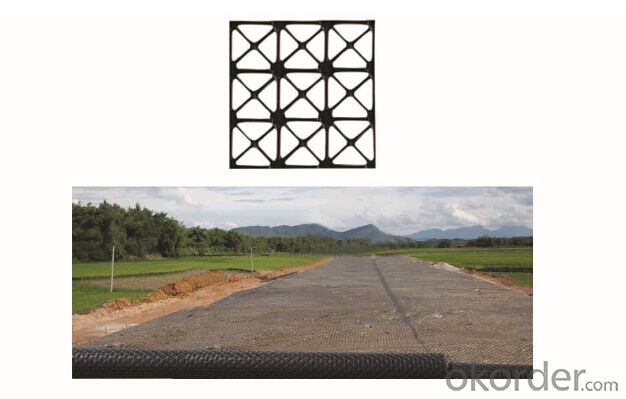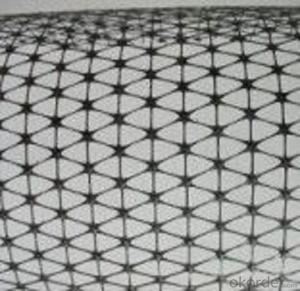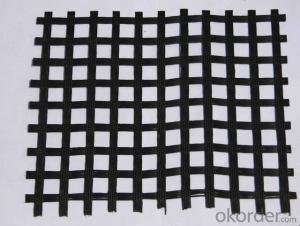Never Run Multiaxial Plastic Soil Geogrid
- Loading Port:
- Qingdao
- Payment Terms:
- TT OR LC
- Min Order Qty:
- 1 m²
- Supply Capability:
- 100000 m²/month
OKorder Service Pledge
OKorder Financial Service
You Might Also Like
Multiaxial geogrid , made of polypropylene plate , is extruded into sheet and then punched into regular mesh and finally streched into the whole tensile geogrid , triangular mesh is combined orgnaticlly.

Product introduction:
three axial triangular grid is a new kind of geotechnical reinforcement materials, the latest development because of its stable structure, triangle, two-way than one-way gratings have more reasonable stability, and can bear the load of multiple directions, at the same time more effectively play the role of distributed load, is the ideal choice of the geotechnical engineering reinforcement reinforcement.
Triangular grid main advantages:
1. With the most stable triangular structure, stress is not easy to occur structural deformation;
2. Able to carry more direction load at the same time, not easy to happen node torsion failure;
3. Because of its rectangular section, is not easy to produce and soil slip, the reinforcement effect is better;
4. Because of the node is larger than two-way grille, efficiency is higher, so the node node is not easy to damage;
More than 5. And because of muscle common node, so more saving materials, are more energy efficient.
Three axial triangular grid performance specification (tentative)
The geometric requirements
SAS15
SAS20
SAS25
SAS30
1) the rib length (mm)
32
32
32
32
2) node thickness (mm)
2.2
3
3.8
4.5
3) the rib section shape
rectangular
rectangular
rectangular
rectangular
4) mesh shape
triangle
triangle
triangle
triangle
1) node transfer efficiency (%) or higher
95
95
95
95
2) low strain when the radial tensile modulus (KN/m, @ 0.5% strain) or greater
225
375
430
475
3) quality control tensile modulus (KN/m, @ 2%) or greater
170
230
280
340
4) the mesh stiffness (kg - cm/deg, @ 5.0 kg - cm) or greater
3.0
3.6
5.6
7.8
Carbon black content of p
2%
Note: 1) node efficiency namely load transfer capacity, expressed as a percentage of maximum tensile strength;
2) is according to the radial tensile modulus ISO10319:1996 by measuring the axial plane of the tensile modulus is measured;
3) quality control according to tensile modulus ISO10319:1996 tensile measurement;
4) the mesh stiffness in the horizontal plane, namely to 225 mmx225mm sample center node by applying a torque measurement. Type TG301 geogrid is by our company on the basis of single and double to geogrid, complement each other, independent research and development of low consumption, environmental protection new grille. Type TG301 geogrid is made of PP material by rotating the nose out of a natural law with a mesh plate is arranged, after orientation stretching a forming type terminal grille, we fully consider the in recent years -- new method for calculating the ground settlement, the secant modulus method, repeated calculation with nanjing iwhr geotechnical engineering research institute, many times
Do the destructive and load test to prove:
Type 1. TG301 geogrids stress load, force to disperse bearing rib direction, uniform load distribution
2. The mechanical properties of the single and double to more stable, geogrid tensile modulus and secant durable ability is stronger, its unique network structure is more suitable for the conditions under different environmental stress.
3. The node is gangsu PP welding gratings have absolute stability.
- Q:What is the meaning of 80 in geogrid TGSG80
- A model can be viewed as a double grid
- Q:Are geogrids suitable for use in mining tailings ponds?
- Yes, geogrids are suitable for use in mining tailings ponds. Geogrids provide excellent stability, erosion control, and reinforcement to the tailings pond structure. They help in preventing soil erosion, enhancing slope stability, and improving overall longevity of the pond. Additionally, geogrids can withstand harsh environmental conditions and are resistant to chemicals present in tailings, making them a reliable and effective solution for mining tailings ponds.
- Q:How do geogrids enhance the performance of geocell confinement systems?
- Geogrids enhance the performance of geocell confinement systems by providing additional reinforcement and stability. They are integrated within the geocell walls, creating a stronger structure that can withstand higher loads and pressures. Geogrids also distribute the applied forces more evenly, preventing localized stress concentrations and reducing the risk of deformation or failure. Ultimately, the use of geogrids improves the overall performance and longevity of geocell confinement systems.
- Q:Are geogrids effective in preventing soil erosion on coastal cliffs?
- Yes, geogrids are effective in preventing soil erosion on coastal cliffs. Geogrids provide structural support to the soil and enhance its stability, reducing the risk of erosion caused by wave action and weathering. They help to distribute the forces exerted on the soil and prevent surface runoff, thereby protecting the cliffs from erosion and maintaining their integrity.
- Q:How do geogrids improve the performance of mechanically stabilized slopes during seismic events?
- Geogrids improve the performance of mechanically stabilized slopes during seismic events by providing reinforcement and enhancing the stability of the slope. They act as a tension element within the soil, redistributing and controlling the forces generated by seismic shaking. This helps to reduce the potential for slope failure, soil displacement, and excessive deformation, ultimately improving the overall resilience and safety of the slope during seismic events.
- Q:Can geogrids be used in railway ballast reinforcement applications?
- Yes, geogrids can be used in railway ballast reinforcement applications. Geogrids provide effective reinforcement to the ballast layer, increasing its strength and stability. By distributing loads more evenly, geogrids help to reduce settlement and deformation, improving the overall performance and longevity of the railway track.
- Q:What are the benefits of using geogrids in construction projects?
- Geogrids offer several benefits in construction projects, including increased soil stability, improved load distribution, and enhanced overall structural integrity. These materials reinforce and stabilize the soil, preventing erosion and reducing the risk of slope failure. Geogrids also help distribute loads more evenly, reducing stress on the construction materials and extending their lifespan. Additionally, geogrids can be cost-effective as they often require less excavation and backfill material, saving time and resources during construction.
- Q:The tensile strength of a steel bar is about the number of cattle per square millimeter per square millimeter. The tensile strength of Gsa's cattle per meter, understand the carrying capacity of tensile Gsa every one meter in width is the number of cattle (considering Gsa gap), or single Gsa every one meter in length tensile capacity is the number of cattle (the size effect of Gsa does not consider the length direction). Please advise!
- The tensile strength of geogrid is most units per meter number kn, because the steel mesh size is uncertain, unlike the types of glass fiber grid less, as long as know what type of glass fiber yarn will be able to know what is the tension
- Q:Fiberglass geogrid is mainly used for old road reconstruction, the main purpose is to reduce reflection
- Geotextiles are used for road, railway, tunnel, dam, tailings treatment, isolation, filtration, drainage, reinforcement, protection and enhancement...Analysis of the causes of cracks in the asphalt overlay, the formation of a new type of excellent geotechnical substrates by special coating process.Asphalt overlay on old cement concrete pavement is a kind of special pavement structure, and its stress and strain characteristics are quite different from those of general elastic layered system.
- Q:What are the factors that affect the tensile strength of geogrids?
- The factors that affect the tensile strength of geogrids include the material composition, manufacturing process, aperture size, junction strength, and the presence of any defects or damage. Additionally, external factors like temperature, humidity, and exposure to chemicals or UV radiation can also impact the tensile strength of geogrids.
1. Manufacturer Overview |
|
|---|---|
| Location | |
| Year Established | |
| Annual Output Value | |
| Main Markets | |
| Company Certifications | |
2. Manufacturer Certificates |
|
|---|---|
| a) Certification Name | |
| Range | |
| Reference | |
| Validity Period | |
3. Manufacturer Capability |
|
|---|---|
| a)Trade Capacity | |
| Nearest Port | |
| Export Percentage | |
| No.of Employees in Trade Department | |
| Language Spoken: | |
| b)Factory Information | |
| Factory Size: | |
| No. of Production Lines | |
| Contract Manufacturing | |
| Product Price Range | |
Send your message to us
Never Run Multiaxial Plastic Soil Geogrid
- Loading Port:
- Qingdao
- Payment Terms:
- TT OR LC
- Min Order Qty:
- 1 m²
- Supply Capability:
- 100000 m²/month
OKorder Service Pledge
OKorder Financial Service
Similar products
New products
Hot products
Hot Searches
Related keywords































